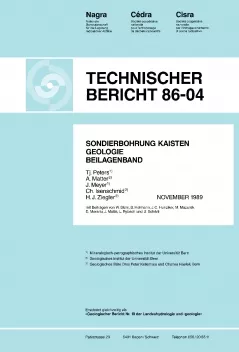
Technischer Bericht NTB 86-04
Sondierbohrung KaistenGeologie
The Kaisten borehole was the fifth (after Böttstein, Weiach, Riniken and Schafisheim) in Nagra's deep drilling programme in Northern Switzerland. It is located within the community of Kaisten, Canton Aargau (Coordinates 644'641.0/265'623.7, 320.38 m a.s.l.), approximately 3 km south-west of Laufenburg railway station. The final depth of the borehole was 1306 m.
Drilling began on 13th February 1984, continued up to 27th June 1984 and was carried out almost exclusively using the conventional rotary drilling method. With the exception of a 5.5 m-long section in the Muschelkalk and two shallow centering boreholes, the whole drilled section was cored. From a depth of 321.50 m in the Crystalline, removal of cores was done by wire line core drilling.
The wide range of field and laboratory investigations carried out included stratigraphic-sedimentological and mineralogical-petrographic programmes, as well as different petrophysical, geochemical and isotope geochemistry investigations. This report is a summary of all data acquired up to the end of December 1986.
Beneath a sedimentary cover just 300 m thick, with Muschelkalk at the top and Permian at the base, the Kaisten borehole entered the crystalline basement at a depth of 296.5 m; investigations were carried out down to a depth of 1306 m.
Sediments
Beneath the 45.2 m thick Quaternary, which consists of Niederterrassenschotter (fluviatile gravels, above) and scree/landslip material (below), lie the Untere Sulfatschichten of the Middle Muschelkalk (1.2 m thick in the core profile); these evaporites are almost completely eroded away. The Lower Muschelkalk with the Orbicularis-Mergel (9.6 m), the Wellenmergel (27.2 m) and the Wellendolomit (10.8 m) is a predominantly dolomitic sequence of marls with isolated limestone and dolomite banks. Using the Karneolhorizont the Buntsandstein can be divided into an Upper Buntsandstein (15.8 m) with sandy-silty clay (Röt) and fine to coarse sandstones and a Middle Buntsandstein (15.8 m) with the Karneolhorizont and the diagonally-layered sandstone. Beneath this is the Rotliegendes with the fine to coarse sandstones of the "Obere grobkörnige Folge" (63.4 m), the siltstones of the "Mittlere feinkörnige Folge" (80.7 m) and the crystalline breccia of the "Untere grobkörnige Folge" (27.4 m).
The sediments encountered dip more or less flatly (≤ 6°) toward the SE-S. There is very little fracturing, the fracture fillings consisting mainly of clay minerals, calcite and quartz. Open fractures are present only at the base of the Middle Buntsandstein and the lowest part of the Rotliegendes between 267 and 294 m.
Besides the water-bearing Niederterrassenschotter (fluviatile gravels), water-bearing zones were found in the Buntsandstein and in the "Untere grobkörnige Folge". The rest of the sediment profile has a low permeability.
Crystalline
The crystalline bedrock consists of a very heterogeneous ("bunter") series of high-grade metamorphic, locally migmatic metasedimentary gneisses which is invaded by acidic and basic dyke rocks (aplites, pegmatites, U- and Th-rich lamprophyres). The series is comparable with sequences in the Southern Black Forest and in the Leuggern borehole. On average, per 100 m of drilled section, 2.9 aplites, 10.4 pegmatites, 1.8 lamprophyres and 8.8 quartz-tourmaline veins were encountered, all being structures which tend to form open fractures because of their mechanical contrast with the surrounding rock. In addition, these planar rock elements are often steeply-dipping.
The Kaisten Crystalline was subjected to intensive post-metamorphic tectonohydrothermal overprinting. 6.4 % of the drilled section shows cataclastic deformations and around 33 % shows evidence of hydrothermal alterations. The different tectonohydrothermal events can be ranked according to age into a sequence showing a "retrograde" development from higher to lower temperatures and lithostatic pressures. Particularly as far as deformation is concerned, the more recent events tended to reactivate existing disturbed zones. This led, to some extent, to the zones which were affected tectonohydrothermally having very complex characteristics.
The first intensive effects under very high temperatures (300 – 400°C) were probably to be seen in the Upper Carboniferous; these were triggered by cataclastic deformations and hot aqueous NaCl-fluids of meteoric origin. A second (apparently Permian) tectonohydrothermal phase led to very extensive jointing and cataclasis, to associated hydrothermal "clayification" resulting in illite-rich clay mineral parageneses and to oxidation (extensive haematite neomineralisations). These overprinting phenomena are very marked in the upper 350 m (general red colouring of the rock). Below this depth, they tend to be restricted to discrete zones with increased fracturing and cataclasis.
An even more recent hydrothermal alteration, which is largely absent in the Crystalline of the other Nagra boreholes, can be identified in Kaisten, i.e. a local kaolinisation originating mainly from steep fractures. Besides kaolinite, smectite and calcite are the most important neomineralisations. Particularly in rocks which had already been subjected to tectonohydrothermal influences, corrosion phenomena led to formation of open solution cavities with some idiomorphic and freely formed neomineralisations (calcite, baryte, siderite, fluorite, haematite, etc.). It is not yet clear to what extent these formations are linked with the kaolinisation.
In contrast with the other Nagra boreholes, isotope geochemistry data from Kaisten indicate very recent geochemical water-rock interactions and potential equilibria between fracture minerals and present-day deep groundwaters.
The fracture orientations show a large scatter but a large number of fractures dipping flatly to the south and west can be clearly documented. These directions show marked parallelism with the planar gneiss structure which apparently functioned as a pre-existing mechanical inhomogeneity. Due to the vertical one dimensional nature of the borehole, it was impossible to decide whether or not there is a very steeply-dipping fracture system orthogonal to the flat-lying fractures.
An average of 58 generally steeply-dipping open fractures were encountered per 100 m. Two different types of open structures were encountered over the whole profile, i.e. actual tension fractures and communicating systems of solution cavities which formed preferentially in cataclastic disturbed zones. 36 water inflow points could be identified, 16 of which can be classified clearly as open structures. The three most important flow-systems are:
a) open fractures in quartz-feldspar-rich gneiss areas
b) open fractures in acidic dyke rocks
c) solution cavities and open fractures in disturbed zones.
